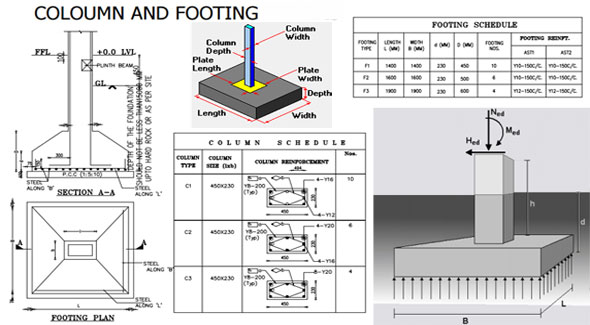Tips to work out the total loads on a column and related footing
- Concrete Cost Estimator
- Concrete Continuous Footing
- Landscape Bidding and Estimating
- Construction Cost Estimating
- Concrete and steel cost estimation
- Construction Cost Estimate Breakdown
- Construction Estimating Worksheet
- Home Construction Cost Estimate
- Estimate Pricing Sheet
- Sheet for General Contractor
- Construction Cost Estimate
- Labor Materials Cost Estimator
- Masonry Estimating Sheet
- Sheet for Building Contractor
- Construction Schedule Bar chart
- General Cost Estimator Sheet
- General Construction Estimate
- Building and Road Estimating Sheet
- Detailed expense estimates
- Door and Window Takeoff Sheet
- General Construction Cost Estimating Sheet

The process becomes complicated for engineering students while measuring loads for column and footings design. Here, in this article, the process is explained in a simple manner.
Types of loads on column:
1. Self weight of the column x Number of floors
2. Self weight of beams per running meter
3. Load of walls per running meter
4. Total Load of slab (Dead load + Live load + Self weight)
The columns are also dependent on bending moments which should have been included in the final design. It is suggested to employ advanced structural design software like ETABS or STAAD Pro for creating the design of a good structure.
The structural loading calculations are based on the following basic assumptions :-
For Columns: Self weight of Concrete should be approx 2400 kg per cubic meter, that is similar to 240 kN. Self weight of Steel should be approx 8000 kg per cubic meter.
Even if we guess a large column size of 230 mm x 600 mm having 1% steel and 3 meters standard height, the self weight of column should be approx 1000 kg per floor, that is similar to 10 kN. Therefore, for calculation purpose, the self weight of column is taken among 10 to 15 kN for each floor.
For Beams: The calculations are same as above. Here, it is supposed that each meter of beam contains dimensions of 230 mm x 450 mm exclusive of slab thickness. So, the self weight should be around 2.5 kN per running meter.
For Walls: The thickness of bricks fluctuate among 1500 to 2000 kg per cubic meter. For a 6″thick wall having 3 meter height and 1 meter length, the load per running meter is estimated as similar to 0.150 x 1 x 3 x 2000 = 900 kg that is equal to 9 kN/meter. This method can be used to work out load per running meter for any brick type.
For autoclaved, aerated concrete blocks like Aerocon or Siporex, the weight per cubic meter should be among 550 to 700 kg per cubic meter. If these blocks are used for construction, the wall loads per running meter become as low as 4 kN/meter, that leads to a major fall in the construction cost.
For Slab: Suppose the slab contains a density of 125 mm. Now each square meter of slab should contain a self weight of 0.125 x 1 x 2400 = 300 kg that is similar to 3 kN. Suppose, finishing load is 1 kN per meter and superimposed live load is 2 kN per meter. Therefore, slab load should be computed as approx 6 to 7 kN per square meter.
Factor of Safety: In the end, after computing the total load on a column, include it in the factor of safety. For IS 456:2000, the factor of safety should be 1.5.

- Application of concrete calculator
- Roofing Calculator can streamline the roof estimating process
- House construction cost calculator
- Engineering column design excel spreadsheet
- Material Estimating Sheet with Excel
- Materials List and Cost Estimate Worksheet
- Concrete Slab Estimating Calculator Sheet
- Common types of foundations for buildings
- Online calculation of construction materials
- Estimating with Excel for the Small Contractor
- Concrete Beam Design Spreadsheet
- Virtual Construction Management app for construction
- Autodesk’s Project Skyscraper
- Reed Construction’s Reed Insight
- Manage your construction project documentation
- Costimator, the popular cost estimating software
- On Center Software for construction professionals
- Free Construction Estimating Software
- Plumbing Calc Pro
- Cost Estimate Worksheet
- HVAC Piping Quantity Takeoff Worksheet
- Construction Estimating Software Sheet
- Estimate Cost Templates
- Construction Punch List
- Construction cost estimating template consisting estimating basic
- Gantt Chart Template for Excel
- Download Civil Engineering Spreadsheets with Verification
- The Building Advisor Estimating and Budgeting Worksheet
- Spreadsheet for design of concrete bridge
- Construction Estimating Software Free








